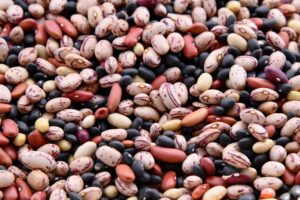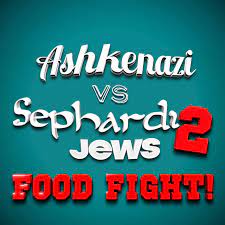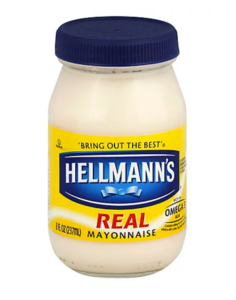Raboyseyee & Ladies,
Kosher for Passover:
On the way home from the Isaacs bar mitzvah this past shabbis, the eishes chayil and Ois were discussing -a shtikel debating- just how Dena and Ben were able to convince the caterer to prepare and serve a chometz kiddish to be followed by a full meal -challah rolls included- with but one week to go before Pesach. Weren’t all the caterers already in Pesach mode? The heylige Ois suggested that the food- the great majority of it, could already have been prepared ‘kosher for Pesach’ and the challah roles previously frozen, ober the eishes chayil -having had a serving of the cholent- insisted that it contained real beans – or what they call kitniyos but one week later. More on this topic below.
We begin this Pre-Pesach review -sans an attached parsha- with a shtikel late shout out and wishes of mazel tov to our dear friends Dena and Ben Isaacs who celebrated the bar mitzvah of their amazing and accomplished son Max this past shabbis. Max, trained by grandpa Schreiber via facetime only (so grandma Rivky told me directly), lained flawlessly, davened, and spoke like a champ. We also heard from the avi-haben (Ben) who shared a fantastically deep and well thought out speech of his own which he delivered with much aplomb. Mazel tov to Max, to your siblings, all uncles’ aunts and cousins – an entire room full of them- the grandparents Linda and Yehudah Isaacs (admission: the Ois has a special place in his heart for Linda), to Dena’s parents, Yitzchok and Rivky Schreiber, to great grandfather Mr. Lazer Fuchs, his wife Ann and to the entire -very extended- Isaacs, Schreiber and Fuchs families.
Sans parsha? Where is the parsha? Here’s the scoop: Parshas Achrei-Mois, read in shul this past Monday and Thursday, will not be read this coming Shabbis, as Pesach laining usurps the parsha. The parsha will be read in its entirety the shabbis following Pesach and the Ois is looking forward to sharing a few pearls upon his return. What to write about without a parsha?
Shoin, come this Friday night, a few million jews scattered all over the world -to include 100-200,000 who will have made their way to Orlando, Florida to teach that antisemite Walt Disney a lesson- will be sitting down to enjoy their respective seders with friends and family. In the coming years, between the holy work of our Chabad brothers and heimishe Yiddin who have discovered the Orlando area, the gates to Disney World will surely be adorned with mezuza’s and Mickey will be wearing a yarmulka and donning tifilin. The bottom line: the record setting number of Yiddin in Orlando for Pesach 2022, includes the heylige Ois and the entire mishpocho.
Did the heylige Ois mention that the eishes chayil had kitniyos in her cholent? Kitni-what? What is that and so what? Whatever it is, seemingly we cannot have it (them) in our cholent or anywhere else over Pesach. Why not? Azoy iz iz (it’s just how it is); it’s just how we grew up. kitniyos were not debated; they were verboten and fartig -case closed. We never asked why. Ober, as we get older, we begin asking questions and this parsha-less week, and because Dena Isaacs ordered up a cholent with beans, the heylige Ois is here with a shtikel rant on kitniyos.

Broadly speaking, kitniyos are legumes as well as corn and rice -the list has since expanded- which some rabbi or rabbis in Ashkenazi communities prohibited for consumption on Pesach? Why? Because they could! The claim – which became widely accepted- was that these items -when ground- looked epes too similar to wheat flour which is pure chometz and forbidden on Pesach. In other words: because the rabbis thought they looked like real wheat chometz, people might see real wheat flour, touch it, eat it, and enjoy it (all forbidden over Pesach), all while mistakenly thinking what they enjoyed were but legumes. And just like that, legumes and assorted other items became verboten over Pesach. The bottom line: legumes were guilty by association. Fartig and veyter! That being said, what are vegans who eat legumes daily for sustenance to do over Pesach? Just who enacted this anti-kitniyos ban? Here’s what we know: The decree -having seemingly begun as a minhag (a custom) and which somehow became law, was initiated by one or several rabbis sometime in the 13th century.

And why is this topic of interest? How is all this at all related the Ois’s family? And the answer is azoy: several years back, two of our children declared themselves vegans and ever since, Pesach preparation and specifically menu planning has taken on new meaning and challenges. What to do? Can one survive on matzo alone? Without consuming what now represents the korban Pesach in the form of a good piece of meat? Without chol-hamoed BBQs? No matzo and cream cheese? Without matzo-pizza? Say it’s not so; it’s mamish sacrilegious. What to do? Over an eight-day Yom tov where the average male consumes many -too many- pounds of chicken, beef, and lamb in various shapes, forms, and sizes, what are the vegans to eat? Just how many Impossible Burgers can they be expected to chomp down over the 10-11 days together?
Nu, the RBSO is avada great and it so happened that a gentleman in the Ois’s office – let’s call him Ephraim- is a convert. He had seen the light: his conversion was not minor; he did not convert from goy to Yid. In fact, he was born Jewish and so remains. His move, even bigger! At a mature age -let’s say mid 50’s, he converted from Ashkenaz to Sefard. In any event, when the Ois shared his concerns over the Pesach menu for his vegans, the convert suggested that the Sephardic menu be explored. Is that allowed? Is the Sephardic Pesach menu different? Do they eat chometz on Pesach? May an Ashkenazi family look at and embrace certain Sephardic traditions at will? Can one become Sephardic for Pesach only? And what’s so damn good about becoming Sephardic anyway? With that introduction, let’s talk kitniyos and the role they play in the Ashkenazi and Sephardic Pesach menus.

In previous editions of the Pre-Pesach post, we focused on price gouging, the somewhat questionable but widely observed chometz sale to the goy -using the good rabbi as the middle man. Ober this year, and new for 2022, let us take a shtikel dive into kitniyos. Why kitniyos? What’s controversial about them?
It seemingly all began sometime in the 13th century, when a rabbi, or a group of them, got together and decided that kitniyos (aka: kitniyos), were henceforth prohibited to be consumed on Pesach. Why? Go back to the beginning and re-read what’s written. The bottom line: ever since, the Pesach custom among Ashkenazic Jews has been to prohibit kitniyos which now include legumes, rice, seeds and corn, chickpeas, popcorn, millet, lentils, edamame, and corn on the cob; these have all been off the menu and table. We don’t eat them because the minhag which many can’t stand, does in fact stand. It’s a case of minhag k’din (the custom is now the de facto law). These newly forbidden items inspired many new Jewish entrepreneurs to create yet more new products without the forbidden ingredients, ober were they content? Not! In our times, the list of forbidden items continues to grow and now also includes what is known as “derivatives of kitniyos,” including derivatives that cannot ever be confused with grain or flour. These include soybean oil and peanut oil. And shoin, today we cannot use peas, caraway, fennel seed, mustard, garlic, soybeans, and peanuts. Let’s keep this in mind when you go out and buy coke with that yellow cap: corn syrup, the sweetener in soda and many other sweetened products, is also a kitniyios derivative.
Luckily, for my own parents, OBM and many others, potatoes remained on the approved list though not without controversy. Unlike peas, potatoes can make indeed make a flour that is used quite effectively in baking Pesachdike (Kosher for Pesach) cakes and brownies. Ban it now! Nevertheless, potatoes are not prohibited. How did it escape the wrath of the kitniyos police/ganovim entrepreneurs? To the potato’s rescue came Rav Moshe Feinstein, OBM who argued azoy: potatoes were initially not prohibited because they simply weren’t known in Europe. Once they became known, they weren’t prohibited because there were early authorities that considered the kitniyos prohibition a “foolish custom.” And on this basis, Rav Moishe permitted peanuts; he also permitted peanut oil with the additional reason that it was a derivative. The bottom line: according to Rav Moishe (Igrois Moishe, Orach Hayyim 3.63) is azoy: items traditionally prohibited would continue to be prohibited, but there was no basis for expanding upon the list of prohibited items.
Hey, what about the coffee bean? May we drink coffee? And the good news: back in the 1930s, Maxwell House coffee hired the Joseph Jacobs advertising firm to market to a Jewish demographic. The agency hired a rabbi to research the coffee bean (of course) hoping to hear that the bean is exempt from any kitniyos restrictions, and guess what? The rabbi determined that the coffee bean is more like a berry than a bean, thus making it kosher for Pesach! Shkoiach! Case closed and coffee lovers were able to breathe again.
Nu, efsher you’re klerring azoy: let’s just abolish this seemingly unnecessary minhag. And guess what? You are not the first to have this idea, nor the last. In fact, some authorities consider it obligatory to abolish a stupid custom. Back in the 18th-century Rabbi Yaakov Emden wrote that he would have abolished the custom had he had the authority to do so. More recently, Rav Moshe Feinstein, OBM, did not advocate abandoning the custom, but opposed expanding the list of forbidden kitniyos. And look at this: In the 19th century, Reb Yisroel Salanter, the founder of the Musar (ethics) movement in Lithuania, ate kitniyos mamish on Pesach in public during a time of scarcity, dramatically demonstrating that kitniyos were not the same as chomatze (which he clearly did not permit). It’s zicher the case that scarcity has not been a serious issue in recent times, ober modern arguments against the minhag focus on how it raises the cost of observance, how it detracts from the joy of the holiday, and how it divides the Jewish community, especially when Ashkenazim and Sephardim are intermarried. Every year, new articles are published with the pros and cons of getting rid of the kitniyos prohibition. Will it happen? Mistama not before chicken and turkey go back to the parve menu. In other words: it’s not happening.
Back to the family vegans, and others -limoshol those who with unique dietary restrictions: may they jump ship, abandon their Ashkenazic brethren and act Sephardic for the holiday? And why is that better? The Ois decided to reach out to a very choshova (esteemed) rabbi, one well versed in kashrus, one who has answered many thousands of questions over the decades he served and asked azoy: “Rabbi, what can my vegans eat?” Can they in fact become Sephardim for the duration of the chag? And his answer? He didn’t address outright conversion on a permanent basis but he did say azoy: Yes they can! He went on to tell me that our vegans are now in a class of those in need of a special diet. Limoshol, as if they were glutton free or had other dietary restrictions for whatever reason, and therefore, he suggested that they in fact follow Sephardic customs. Must they now drive only black German cars, wear only black kipot, and must they remove them immediately after davening? And the good news? They -the great majority of Sephardim- never signed onto the proclamation made by the 13th century rabbi or rabbis and hence their menu includes kitniyos. It always did! Halleluiah and praise the RBSO. I then asked if we needed sperate dishes, pots and pans. He stated with certitude that kitniyos are NOT chometz and case closed! We did not need separate dishes or anything else. More good news: the vegans sitting at the same seder, mamish right near us Ashkenazim, could enjoy rice and oh- so many other items, one’s head could spin. In fact, believe it or not Trader Joe’s sells certain breads -yes, bread mamish- that are allowed on Pesach for Sephardim. Well, blow me down!

With that information, I went back to the convert and asked what list he consults and relies on for his kosher for Pesach products. It was at that moment that the convert opened the Ois’s eyes wide to a world he had not previously known. The heylige Ois, who had previously only known from OU-P, and the OK list, was introduced to a site known as Kashrut.org. Who are they and why is the Ois shouting them out? Let’s first read this from their site: “Kashrut.org is a Jewish organization dedicated to making it easier to lead an observant, authentic Jewish life. About 40 years ago, the Abadi brothers got together and made a pamphlet of kosher foods and mailed it throughout their community. Their goal was to show that keeping kosher was possible without overwhelming dietary restrictions. Today, they continue to help folks find ways to keep kosher without interrupting their lives. The items on each list and the Jewish Laws presented here are all based on Halachic (Jewish Law) decisions by Rabbi Yitzhak Abadi.”
Who then is Rabbi Abadi? Let’s meet him; The image and information below from the Achroin Wikipedia.

| Title | Posek |
| Personal | |
| Born | Yitzchak Abadi
March 12, 1933 (age 89) |
| Religion | Judaism |
| Spouse | Chaya |
| Children | Chaim Yisrael, Nechama, Avraham, Aaron, Yehuda, Rivka |
| Denomination | Haredi Orthodox Judaism |
| Occupation | Rabbi |
| Position | Rosh Kollel |
| Yeshiva | Kollel Ohel Torah, Lakewood Township, New Jersey |
| Residence | Lakewood NJ, USA |
Yitzchak Abadi (born March 12, 1933) is an Orthodox Jewish Rabbi and Posek and a prominent leader of Orthodox Judaism in the United States and around the world.
Rabbi Abadi was born in Venezuela and moved together with his parents to Tiberias, Mandatory Palestine at age 2. As a child Rabbi Abadi attended school in Haifa. Rabbi Abadi’s studies began in the Yishuv Hachdash in Tel-Aviv, Israel and continued in Yeshivat Chevron in Jerusalem. At 19 years old, Rabbi Abadi was sent by the Chazon Ish to study in Montreux, Switzerland. A year later the Chazon Ish sent Rabbi Abadi to study in Lakewood, NJ, under the famed Rabbi Aharon Kotler.[1]
Rabbi Abadi is a posek, and his students are rabbis across the globe. After Rav Kotler’s death, Rabbi Abadi emerged as the leading posek for the entire Lakewood community. Rabbi Abadi branched out on his own in 1980, opening a premiere halacha kollel in Lakewood. In 1993, Rabbi Abadi transferred his kollel to Har Nof, Jerusalem, where it continued to produce scholars who are trained to decide halachic questions touching on every aspect of Jewish law.[1] Rabbi Abadi moved back to Lakewood in 2009.
The bottom line: He looks as a rabbi should, his beard is long enough, his resume is stellar -it includes “lives in Lakewood,” and many pages can be written on Rabbi Abadi, and now, also his children. In fact, he looks angelic. Ober does everyone agree with Rabbi Abadi? Not! Why not? It’s like this: as with kimat everything in our glorious religion, specifically the practice of it, even more specifically, when certain rabbis seek to make life easier, which -as a direct result- might have a deleterious effect on the pockets of other Toirah inspired entrepreneurs, he is not without controversy. Ober, asks the Ois azoy: How could a man who looks as does he stir controversy? His rulings specifically affect those in the business of selling kosher and kosher for Pesach products. In other words: they consider his hands to be in their pockets. How dare he declare certain ingredients and products chometz free, always? Mamish? What’s on the list? The list Raboyseyee, will astound you and have you scratching your respective heads. He put in the work and discovered that hundreds of ingredients and products we were trained to believe are not kosher for Pesach without certain markings from well-known organizations, are in fact kosher and do not require the OU-P or other stamps. They always were kosher because they never did contain any chometz! Did you know that Häagen-Dazs and most other ice creams (Klondike, Dove Bar, and others) do not contain chometz ever, and can be eaten on Pesach without special markings? Check out the entire list here https://kashrut.org/?page_id=25 Be amazed!

The bottom line: many more pages can be written (and have over the years) on this always hot topic. The heylige Ois does not pasken shaylis (issue rulings) -unless of course he were to find certain garments in his mailbox- if you chap, ober he wants to share this information for those who want to know, and those who might benefit from it. The good rabbi the Ois consulted does not rely on Rabbi Abadi for all his needs; he certainly tows the party line, and follows the lists of the widely accepted agencies that do this for a living. He did however tell the Ois that for individuals whose dietary needs dictate a modified menu, the list put out from the Abadi brothers who follow the rulings of their esteemed father, can be relied upon. He does tell those with restricted diets to follow the Abadi list. What he did not tell me was that Hellman’s Real Mayonnaise -also on the Abadi list- is always kosher for Pesach even without the special Pesach marking. It too is on the list.

The final bottom line: says the heylige Ois who is not afraid of some controversy azoy: were Rabbi Abadi or his sons’ charlatans, neither Sephardim, nor those with unique needs could rely on him; the opposite is true. They are good people trying to make life easier for those who want to observe the laws and not necessarily the always new chumras that keep popping up from those seeking to make a business of selling items for Pesach at inflated prices? Do tissues really require a kosher for Pesach mark? Does hand-made shumra matzo need to cost as much as $80/lb? The long list of egregious pricing goes on. Shoin, having ranted, I feel much better.
Wishing you all a happy and kosher Pesach.
The Heylige Oisvorfer Ruv
Yitz Grossman
